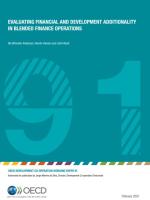Development results should be systematically assessed in blended finance
Blended finance has attracted a lot of attention in recent years, and blended finance is considered as a potential way to ensure development finance for the SDGs. In spite of the strong promotion of blended finance a consensus on main terms and concepts is still lacking, and there is no agreement on how to assess financial and development additionality of blended finance programmes and projects.
Based on a review of documents from a number of bilateral and multilateral donors as well as academic literature this recent OECD Working Paper provides a number of suggestions, including that more clarity is established not only of main terms such as financial and development additionality, but also of various dimensions of additionality. It also suggests that the counterfactual should be considered, and what would have happened without the blended finance interventions, and to move away from simple before and after methods, which are often used in assessments of blended finance. Finally, it argues that assessments of blended finance capture a broader set of effects and development outcomes – both positive and negative.
The study has received financial support from the Danish Ministry of Foreign Affairs.
DIIS Experts


